However, the grim day was made grimmer by realizing that I'd lost pretty much all of my Heucheras - again. It's really nothing new, rather the opposite - thanks to the usual suspects and most dreaded pest in my garden: vine weevils. Grrrrrrr - just the thought of them makes me murderous!
The adults of Otiorhynchus sulcatus, to give them their zoological name, are dull grey-black beetles with "corrugated hard shell" wing cases and a long "snout" or "trunk" - hence the German name Ruesselkaefer and the other English common name snout beetle, although I have never heard the latter used in real life. They are about 1 cm long and move very slowly and in an almost robotic way. When found, they tend to drop and fall on the backs, pull in their legs and play dead. The tell-tale sign on plants like Bergenias, Camellias or Rhododendron are leaves that look like they've come too close to a hole-punch.
But perhaps elsewhere they do serious damage in open ground, too, and it is just our heavy clay that stops the vine weevils - they definitely prefer light, loose soil such as multipurpose compost. Anyway, the worst bit is that you usually don't notice any infestation until it's too late: your plant may seem a little limp, you water it, it doesn't pick up much and only then you may become suspicious. You grab the plant and - sometimes you do not even need to give it a tug to have the whole victim in your hand. Usually without a single root left!
Neither method, of course, is going to help much once the damage is done. Often these devils have gnawed so deeply into the Heuchera's rootstock that you can't even reach and get them out - unless perhaps by using a wire. And even then you can't be sure you've detected them all. So I plunge the whole plant (or what's left of it) in a bucket of water and then leave. 24 hours should be sufficient, I guess, but I tend to leave for days or even weeks. Not ideal, I know, but that's the reality. I do, however, make sure many leaves and the immediate heart of the plant (where new leaves grow from) are clear of the water.
Rescuing Heucheras can be easy - or impossible
Then, when I have time again or remember, I remove all rotten leaves and leafstalks and with any luck some tiny, almost glassy new roots will have sprouted already. Otherwise they tend to do so soon from those "freshly peeled scales" - for want of a better description - where you have pulled away those dead leafstalks. In the picture above, the Heuchera on the right has had this treatment already, the centre and left one still have the rotten bits attached.
Even better, you can pull or break off those plantlets attached to the main woody rootstock - clearly seen on the right plant in the picture above - and pot them up to grow into new Heucheras. In essence, you are propagating though after a vine weevil attack it is more of a rescue operation.
For me, it usually is the attempt to rescue a particular variety, such as favourites 'Midnight Rose', 'Firefly', 'Paris', 'Lime Ricky', 'Berry Smoothie' or 'Fire Chief'. Sometimes I succeed, sometimes not - simply because the evil weevils have munched away the entire rootstock as well, not just the roots, and there is literally nothing left where they could sprout new roots from. Just leaves. What surprises me most, is the fact that even in such extreme cases the latter still look reasonably fresh! Unless you are constantly on your guard and regularly check, you just won't detect this pest in time!
So what measures of pest control are there? Chemical warfare, of course. There are insecticides on the market that are applied as a liquid drench and work their magic - or dark power, depending on which side of the organic debate you stand on - for a number of months. I've heard of Provado (more precisely Provado Vine Weevil Killer 2) and a friend assures me it really works well. It is a systemic insecticide for container grown plants only - i.e. not for open ground - and not to be applied to soil in which edibles are raised. (So no good to protect strawberries, the vine weevil's other favourite in my experience.)
Chemical warfare, biological weapons...
Personally, I would not want to rule out chemical measures on principle, i.e. that on no account should you ever use "poison" or "chemicals". It just so happens that I prefer to not use them because - well, I have small children, I love the wild life in my garden and do not want to harm other species than vine weevils. It just feels "more right" to leave chemical measures out altogether. If you do want to use them (and there may well be reasons to do so), mid- to late summer or early autumn apparently is the best time to apply such drench due to the vine weevil's life cycle, more of which further down.
Talking of principles leads me to the next option, because in principle I really like the idea of biological pest control. Which in this case means nematodes. Products containing these microscopic worms are available to buy from specialist suppliers via mail order or in good garden centres and you apparently mix with water and apply to the soil. The nematodes will then dispose of the vine weevil grubs in their own distinct way: enter the larvae's bodies, release a specific bacteria that kills the host, and then they feed on the corpse and breed and multiply and attack more grubs. Mmmm, nice!
The catch here seems to me that you need a certain temperature range for it to work effectively. The RHS website mentions two nematode species in particular, Steinernema kraussei and Heterorhabditis megidis. For the first the soil temperature should be between 5 and 20ºC, for the latter an even more specific 12 - 20ºC.
That may not sound like much of a problem, but pots tend to heat up more and more quickly than the open ground and likewise will chill down faster and more severely during night times and in the colder months. Also, the nematodes will need a certain moisture level and pots dry out quickly. Will they be killed off, if I do not manage to water very regularly? Still, I think I might give this method a try someday.
... and good old mechanical methods
Let's get back to the life cycle of these pests: Apparently, adult vine weevils are most active in spring and summer, when they not just munch on leaves but lay their eggs near the base of suitable "host plants". (Though this is the usual term, I wonder whether we really should call it host - I wouldn't want to be called "host" to someone if he came round uninvited to chew off an arm and a leg of mine! But there you are, that's just an aside...)
One recommendation is putting a thick layer of sharp gravel or horticultural/ landscape fabric on the soil underneath the most vulnerable plants, the idea being that it will stop the adult vine weevils laying their eggs there and/or the hatched larvae from entering the soil. That seems all fine until you then try watering the pots with a hose regularly... I also do not like the aesthetic appeal of fabric on the pots. With such a tiny plot as mine, there's no escaping from any ugly measures. Which is why I do not like the suggestion of trapping the adult beetles with sticky barriers around the pots or smearing the rims of the pot with glue either.
However, while I might try my best to keep the water topped up, it is never going to work for me on a different level: vine weevils may not be able to fly or swim, but they are excellent climbers. Since I have so very many pots crammed together in such a tight space, they could quite simply pass the length of the garden on a "treetop walk" - i.e. simply crawl up and climb one plant and move from there to the next to the next to the next without ever having to "touch down" again, so to speak.
Man the hunter in action...
They will, however, return to some dark corner, soil crack, layer of mulch or garden debris to hide during the day, so if you know where to look, you may find them there. Some recommend providing "hiding traps" and then pick up and dispose of the beetles during the light hours. Well, lets cross fingers the vine weevil prefers your "hotel" to any other...
More effective, though still time consuming, is to go on a hunt at night time. Dearstalkers optional, you spend balmy spring and summer nights taking a torch and scooping up the little nasties from underneath leaves or leaf margins or where ever else you can spot them. Mind it isn't too strong a torch, or even just go for the romantic option and meet them by candle light...
Why? Because apparently bright light startles them, and then - well, they drop and are even harder to find. Holding a box or - space permitting - even an upturned umbrella underneath the plant to catch them sounds like a better solution to me. If only I wasn't such an erratic gardener, i.e. someone who does things in bouts rather than regularly! The RHS advises: "Gardeners with vine weevil should keep up their guard because stopping control measures after the apparent disappearance of the weevil can allow numbers to build up again." It's a tough life!
As mentioned at the start of this post, the larvae can do their deadly damage to a wide variety of plants, including shrubs and trees. They "kill woody plants by gnawing away the outer tissues of the larger roots and stem bases" and "bore into tubers of cyclamen and begonia, and into stem bases of cacti and succulents", to quote the RHS website, which by the way calls vine weevils "one of the most widespread, common and devastating garden pests".
In my garden, Heucheras and strawberries in pots are their favourite and default victims, which I have come to accept grudgingly. I've given up on strawberries (not enough return to merit the space, mainly) but no matter how many Heucheras they kill, I tend to buy new ones. That may be stupid, but I have two reasons: first - I simply love the stunning year round (leaf)colour Heuchera and Heucherella provide and don't want to be without it. Bedding plants usually don't last longer either and you still buy them or, if time and space and green fingers allow (or pride forbids you to buy), grow them from seed.
My second reason: I consciously use them as bait. At least then I know where the grubs are! Because the vine weevils head straight for the Heucheras for some reason, they usually leave alone my other pots with plants that may be pricier or much harder to source and get hold of again! In effect, I sacrifice Heucheras to rescue my other plant treasures such as Camellias, Crinodendron, Viburnum or Michelia !
Always look on the bright side of life... :-)
When doing some back-up research for this post, I also looked on the websites of two dedicated Heuchera nurseries from which I have bought in the past (though not online but from their stalls at various plant fairs): Plantagogo and Heucheraholics. I wanted to know what they had to say about the constant threat of vine weevils - and had to laugh when, among other things, I found my own sentiments about the satisfactory feeling of "revenge killing" mirrored there.
Ultimately the whole issue for me boils down to this: as long as there is such a colourful array of Heucheras and Heucherellas out there, each one more tempting than the other, the evil vine weevil gives me the perfect excuse to indulge myself a little and try new varieties for which otherwise I would not have any room in my garden. Now I only have the small problem of deciding which ones to choose - and where to put those rescued plantlets: somehow the number of pots in the garden has miraculously increased...
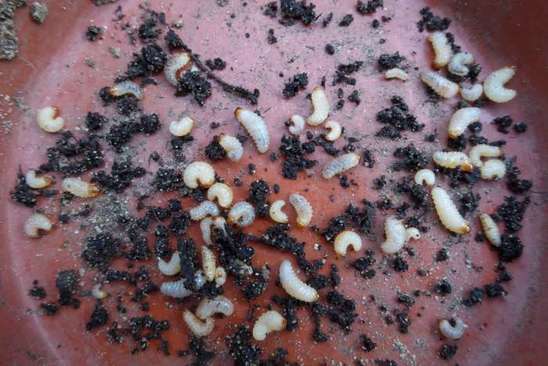
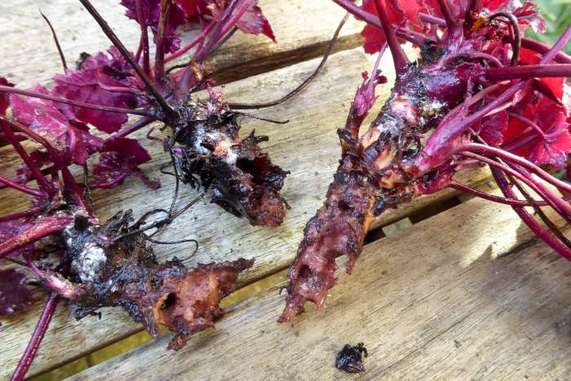
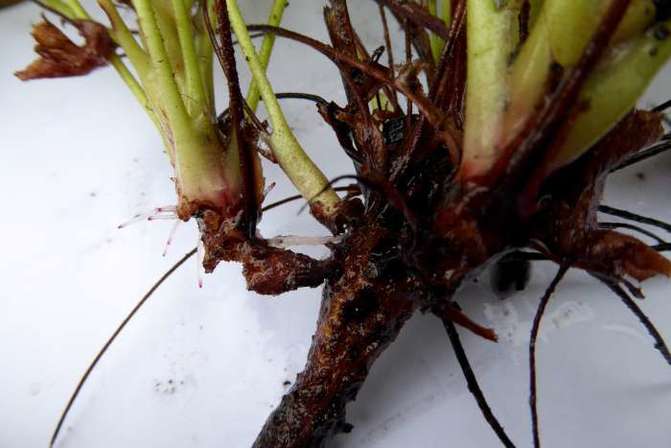
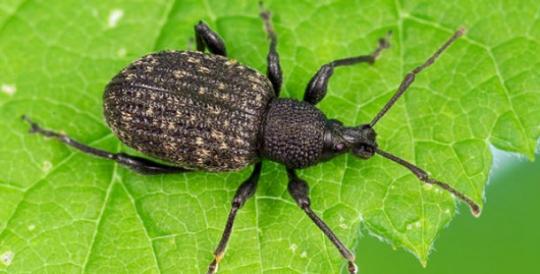
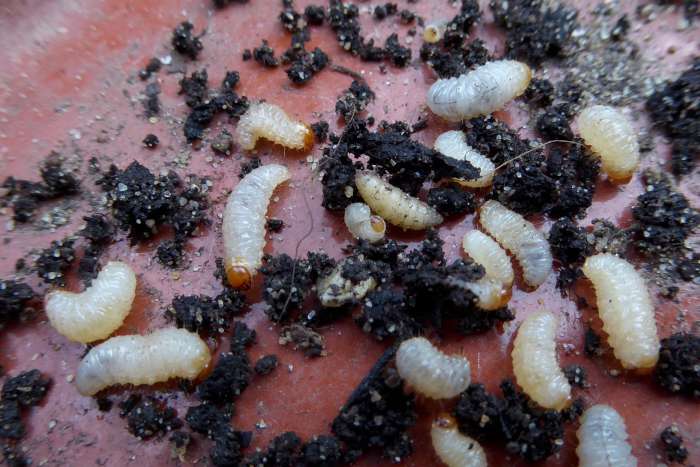
 RSS Feed
RSS Feed